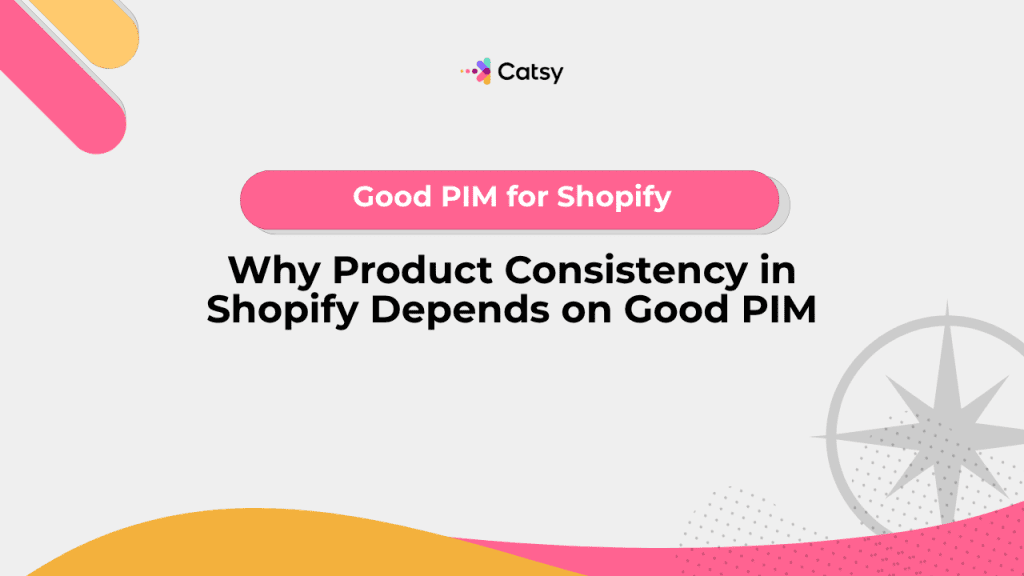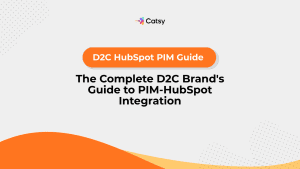Why Product Consistency in Shopify Depends on Good PIM
In this guide, we’ll look at how your product consistency drives your Shopify success, and how a PIM solution like Catsy keeps you aligned and on brand.

Table of Contents
- Introduction
- What Is Product Consistency & Why It Matters
- The High Cost of Inconsistent Product Information
- The Role of Product Information Management (PIM) in Shopify
- How PIM Supports Brand Consistency in Shopify
- Case Examples: What Happens Without PIM
- How Catsy Ensures Consistency Across Shopify Stores
- Conclusion
What You Will Learn:
- Why product consistency is critical for e-commerce success
- How inconsistent data damages the customer experience
- The specific ways PIM protects your Shopify brand
- How Catsy automates catalog content management for consistency
- Best practices for maintaining accurate and trusted product content
In this Article
1. Introduction
Product consistency provides the balance your ship needs to keep you on course.
Visualize your Shopify store as a sailing vessel crossing vast e-commerce waters. To continue on a swift, safe course, you must stay balanced, your navigation must be precise, and your crew should be synchronized.
Without consistency, your Shopify storefront becomes a place of pure chaos! Your details don’t match, your images won’t load, and your titles are contradicting your specs. The result? Confused, disappointed customers who leave negative reviews – or who won’t buy your merchandise at all.
2. What Is Product Consistency & Why Does It Matter
Product consistency means that each and every product in your catalog shares the same information, structure, and branding. That includes:
- Product titles and descriptions
- Sizing and specifications
- SKU details and images
- Pricing and availability
- SEO metadata and marketing copy
Your shoppers bounce between product detail pages to checkout carts, and from mobile to desktop. Through this, they expect a smooth, coherent experience.
According to McKinsey, 71 percent of consumers expect companies to deliver personalized, consistent interactions across channels. When they don’t, 76 of those consumers get frustrated.
Source: McKinsey
Consistency builds trust, credibility, and ease of navigation, all of which lead to higher conversions and customer retention.
Make Catsy DAM and PIM Software an Extension of Your Team
Book a Free Demo3. The High Cost of Inconsistent Product Information
Inconsistent product data equates to a lousy customer experience. That affects your bottom line.
a. Customer Confusion
Imagine a product that is listed with two different titles, three different descriptions, and outdated stock information. This doesn’t just deter purchases! It leads customers away from your store because they can’t trust your brand.
- A customer can’t confirm if they’re getting the right variant
- Mismatched specs cause hesitation
- Incomplete product content forces customers to look elsewhere
b. Negative Reviews & Returns
Inconsistent data often leads to product misrepresentation. If a shopper receives an item that’s different than what they expect, they’re likely to leave a negative review, return your product, or both.
- Return rates soar from unclear sizing or features
- 1-star reviews mention “not as described”
- Support tickets flood in to clarify product details
c. Operational Inefficiencies
Your support and operations teams pay the price of this inconsistency:
- More time spent resolving issues
- Inventory mismatches due to SKU mislabeling
- Constant back-and-forth between teams to clarify data
d. Brand Dilution
Perhaps worst of all, if your data is inconsistent your Shopify brand looks sloppy. You’ll lose authority in your category when you publish errors, typos, or outdated information.
4. The Role of Product Information Management (PIM) in Shopify
A Product Information Management system is like the keel of your e-commerce ship; it stabilizes every moving part of your catalog content.
a. centralization for a Single Source of Truth
When you use a PIM like Catsy, all of your product data lives on one platform. There’s no more chaotic spreadsheets or shaking down co-workers for file versions in their inbox.
What does this mean?
- Everyone, including marketing, dev, support, and others, is working from the same source
- Shopify storefronts will always pull and display the most accurate data
- Discrepancies are spotted and fixed before they go live
b. Data Validation & Enrichment
Catsy’s validation engine catches missing specs, improper formats, and contradictory attributes before they hit your storefront.
Features include:
- Required field checks
- Automated image ratio verification
- Unit of measure consistency
- Rich content tagging for 3D, PDFs, and video
c. Omnichannel Catalog Content Management
With PIM, managing catalog content management becomes intuitive:
- You can publish data to multiple Shopify stores, marketplaces, or business-to-business portals
- You’ll control exactly what each channel receives
- Teams can tailor descriptions, assets, and price points based on channel
5. How PIM Supports Brand Consistency in Shopify
Let’s take a few moments to explore how PIM maintains alignment between your brand and your Shopify storefront.
a. Structured Product Pages
A robust PIM ensures that your product detail pages are well structured, easy to scan, and visually aligned across the board.
- Titles follow a naming convention
- Bullet point benefits are consistent
- Product hierarchies and variants are intuitive
b. Accurate Variants and Attributes
Whether you’re selling products by size, color, compatibility, or tech spec, PIM ensures that each variant has the right image, description, and dimensions. Availability should also be current.
With Catsy, you can also pre-define attributes and validation rules; this removes guesswork for your teams.
c. Consistent Visual & SEO Metadata
Catsy ensures that each of your brand images, thumbnails, alt tags, and meta titles stay consistent and optimized.
- Control alt text for ADA compliance and SEO
- Align image resolutions with Shopify’s best practices
- Use meta templates for scalable SEO optimization
d. Localization & Language Control
Going global? PIM makes it simple to maintain product consistency across different languages and regions. Catsy supports:
- Region-specific copy and pricing
- Multilingual asset versions
Content localization rules per Shopify store
6. Case Examples: What Happens Without PIM
Let’s look at a few examples of how the absence of a PIM can shipwreck your Shopify consistency.
Scenario | Without PIM | With PIM via Catsy |
Launching new products | Manually copy-paste info into Shopify | One-click sync from PIM to all Shopify stores |
Running seasonal promotions | Data scattered across marketing and ops | Unified product copy, pricing, and banners |
Localizing store for Canada | Duplicate listings cause confusion | Controlled localization from central dashboard |
Managing 500+ SKUs | Inconsistent specs, image mismatches | Structured catalog with validated attributes |
7. How Catsy Ensures Consistency Across Shopify Stores
Catsy was built with Shopify merchants in mind, and we can help you sail smoothly. Whether you have a flagship store or a whole fleet of storefronts, you’ll enjoy:
- Unified Product Database: Keep all versions of every SKU in sync
- Digital Asset Management: Connect assets to products automatically
- Data Governance Rules: Set requirements, validations, and automations
- Bulk Edit & Import Tools: Update thousands of listings instantly
- Shopify Mapping Templates: Match Catsy fields with Shopify metafields and product schema
With Catsy, your Shopify brand will stay consistent, accurate, and professional, no matter how complex your catalog.
8. Conclusion
If you’re navigating e-commerce without consistency, you’re entering a storm without a compass. Your customers expect a seamless experience across each of your stores, including Shopify! Without this clarity and trustworthiness, they’ll abandon carts, leave negative reviews, and never return.
But ahoy, mates! A powerful product information management system like Catsy can help you sail with confidence! From catalog content management to image optimization, each touchpoint is a clear representation of your brand.
9. Key Takeaways
- Product consistency boosts trust, conversions, and brand perception
- Inconsistent product data leads to returns, bad reviews, and inefficiency
- PIM centralizes data and validates content for Shopify storefronts
- Catsy ensures structured, enriched product pages and variant accuracy
- Good PIM is essential for scalable catalog content management across Shopify
Want more tips, tutorials, and insights on product content and e-commerce operations?
Stay connected. We post regularly to help brands like yours scale smarter.
Are You Ready To streamline your product content management?
Continue Reading

The Complete D2C Brand’s Guide to PIM-HubSpot Integration: From Product Data to Personalized Customer Journeys
Read More »
10. Frequently Asked Questions
PIM centralizes your product data and validates fields. It ensures that your content is enriched and structured. Then, it publishes clean data to Shopify. This eliminates discrepancies and leaves little room for human error.
Yes! Catsy supports multi-storefront environments with tailored content rules for each store, ensuring consistent localization and branding.
Titles, descriptions, specs, images, videos, SEO metadata, pricing, variants, localization, and more!
Yep! Catsy offers direct API integration with Shopify, allowing for real-time product data sync and full compatibility with Shopify metafields.
So very much! Catsy eliminates manual entry, automates enrichment, ensures data validation, and keeps your product catalog structured and scalable. Spreadsheets simply can’t handle this at scale.
Subscribe For More Content
Sign up for monthly tips on how to drive revenue with product content.



